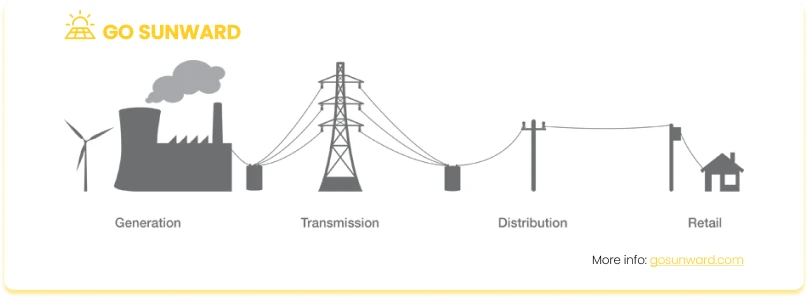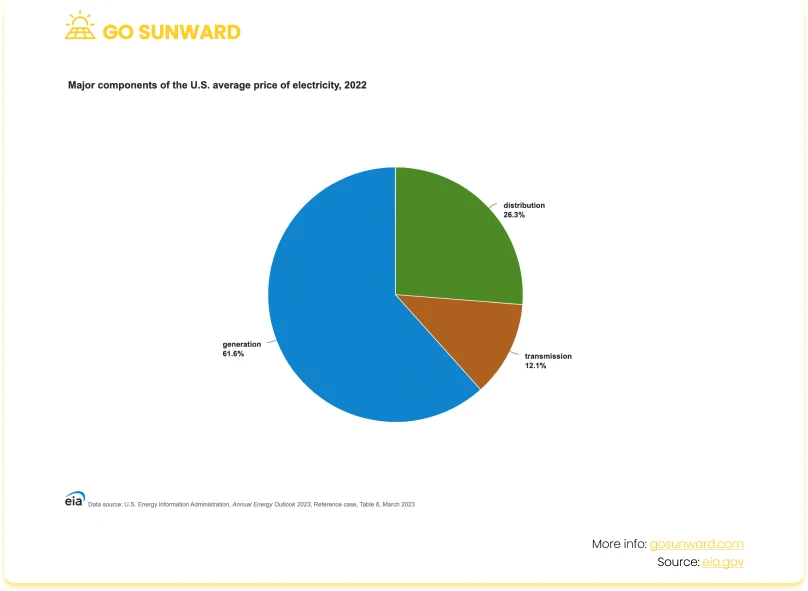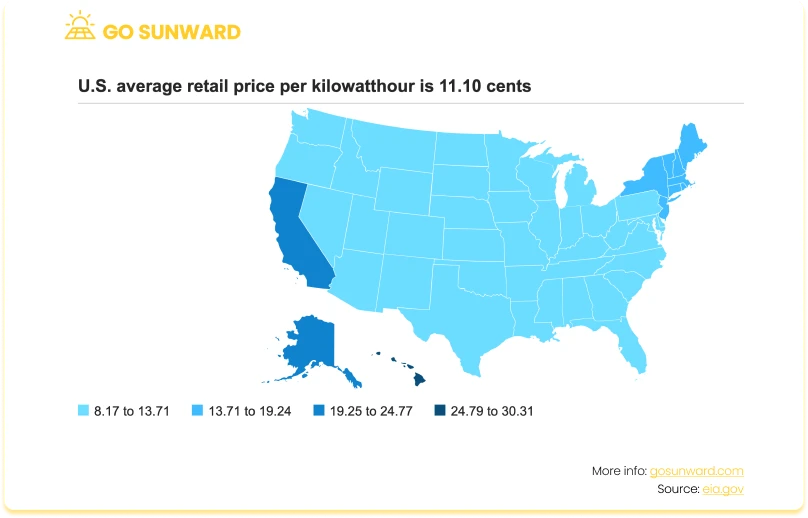Average Electricity Costs
Electricity is an essential component of modern life, powering our homes, businesses, and industries. As energy consumption continues to rise, it becomes crucial to understand the factors that influence electricity costs. In the US, average electricity prices vary significantly based on location, consumption patterns, and various economic and environmental factors.
This article will examine the intricacies of average electricity costs in the US, shedding light on what drives these costs and how consumers can navigate this price and usage landscape.
Understanding Average Electricity Costs
So first and foremost, let’s find out what average electricity costs are in the US, before looking more closely into what goes into the pricing structures and variabilities.
In 2022, according to the Energy Information Administration (EIA), the US annual average retail price of electricity was about 12.49¢ per kWh. This average is comprised of the different annual average retail electricity prices by the major types of utility customers:
- Residential: 15.12 cents (¢) per kWh
- Commercial: 12.55¢ per kWh
- Industrial: 8.45¢ per kWh
- Transportation: 11.66¢ per kWh
Residential and commercial users typically encounter higher retail electricity prices due to increased distribution expenses linked to their electricity provision. Conversely, industrial consumers employ larger electricity volumes, frequently at higher voltages, leading to a more streamlined and economical supply. The electricity retail price for industrial clients typically tracks the wholesale electricity price.
Electricity Costs 101
Electricity prices are determined by breaking down the overall cost structure into three primary components: distribution, generation, and transmission. Each of these components plays a crucial role in the intricate process of delivering electricity to homes, businesses, and industries. You also might want to check how how much electricity you can get from solar – maybe it’s enough to cover all your electricity costs!?

Distribution: This component involves the local delivery of electricity from substations to individual consumers. It encompasses the maintenance and operation of power lines, transformers, and other infrastructure needed to ensure that electricity reaches homes and businesses reliably. Distribution costs are influenced by factors such as the length of power lines, the density of consumers in an area, and maintenance requirements.
Generation: Generation refers to the process of producing electricity at power plants. These power plants could be fueled by various sources, including coal, natural gas, nuclear, hydroelectric, wind, solar, and more. The costs associated with generating electricity depend on the type of fuel used, the average energy prices, the technology employed, operational expenses, and the efficiency of the power plant.
Transmission: Transmission involves the high-voltage transport of electricity over long distances from power plants to local distribution substations. This phase requires a network of transmission lines, transformers, and substations to ensure that electricity loss is minimized during the journey. The costs associated with transmission are influenced by the infrastructure required and the maintenance needed to keep the transmission system efficient and reliable.
When determining electricity prices, these three components are taken into consideration. Utilities and regulatory bodies analyze factors such as the cost of fuel, maintenance expenses, infrastructure upgrades, environmental regulations, and financial returns to set rates that cover the expenses incurred in each phase of the electricity supply chain. Certain for-profit utility companies also factor in a monetary return for proprietors and shareholders within their electricity rates.

Why Do Average Electricity Costs Vary?
Electricity prices can vary greatly by locality based on several factors such as the availability of power plants and fuels, local fuel costs, and pricing regulations. For example, in 2022, the annual average retail electricity price for all types of electric utility customers ranged from 39.85¢ per kWh in Hawaii to 8.24¢ per kWh in Wyoming. In this example, prices in Hawaii are high relative to other states mainly because most of its electricity is generated with petroleum fuels that must be imported into the state. In other cases, states with abundant renewable energy resources often have lower electricity costs due to reduced reliance on fossil fuels.

Four key factors influence your electric bill:
1. Energy Sources & Fuel Costs:
The mix of energy sources used for electricity generation plays a significant role in electricity prices. States that heavily rely on coal or natural gas for power tend to experience higher electricity costs due to the volatility of fuel prices and environmental regulations. Conversely, states with robust renewable energy portfolios often enjoy more stable and cost-effective electricity prices. According to the Washington Post, the states with the largest share of electricity from wind are Iowa, Kansas, South Dakota, Oklahoma, North Dakota and Nebraska, while the states with the largest share of electricity from solar are California, Nevada, Vermont, Massachusetts, Utah and North Carolina.
2. Weather Conditions:
Extreme temperatures can increase demand for heating and cooling, and the resulting increases in electricity demand can increase fuel and electricity prices. Rain and snow provide water for low-cost hydropower generation. Wind can provide low-cost electricity generation when wind speeds are favorable. However, when droughts or competing demand for water resources occur or when wind speeds drop, the loss of electricity generation from those sources can put upward pressure on other energy or fuel sources and prices.
3. Regulations:
State and federal regulations can influence electricity prices. Regulatory measures like renewable energy standards, emission reduction targets, and market deregulation can impact supply, demand, and ultimately, pricing. These policies shape the transition towards cleaner and more sustainable energy systems.
4. Infrastructure and Transmission:
This significantly affects regional electricity prices due to the costs associated with building, maintaining, and upgrading infrastructure and transmission systems. Longer distances or challenging terrains lead to higher transmission costs, which are reflected in pricing. Reliable infrastructure ensures stable supply, while investments and upgrades for growing demand or renewable integration contribute to pricing. Energy loss during transmission impacts efficiency, and measures for resilience and security incur additional costs, collectively influencing regional electricity pricing dynamics.
How To Navigate Your Electricity Usage & Bills
Your own average electricity costs are affected by the different appliances you have at home and the activities you undertake. For example, items such as air conditioning systems, water heaters, and larger appliances like refrigerators are known to consume a significant portion of your electricity and will increase your bills. For more information on what costs a lot of electricity in your home, click here.
Energy-saving practices, such as using energy-efficient appliances, improving insulation, and adopting energy-conscious habits, can significantly lower both electricity usage and save money for households.
- Energy Efficiency: One of the most effective ways to manage electricity costs is by enhancing energy efficiency. Simple actions like using LED bulbs, upgrading appliances to ENERGY STAR-rated models, and sealing gaps in homes can lead to substantial savings.
- Renewable Energy Options: Exploring renewable energy options like solar panels can provide long-term cost stability and decrease reliance on traditional power sources. Many states offer incentives and tax credits for renewable energy installations.
- Consumer Awareness: Educating oneself about local regulations, pricing structures, and energy consumption patterns is crucial. Monitoring electricity bills and utilizing online tools can help consumers track usage and adjust behaviors accordingly.
Help Is At Hand
Amid mounting worries about the cost of living, surging electricity rates, and the growing adoption of solar panels, consumers are seeking guidance on effectively navigating and comprehending their electricity costs and usage.
To simplify this process, several electricity price-comparison tools have emerged, helping consumers make informed decisions. Government-operated websites sometimes offer electricity price-comparison tools, which provide unbiased and up-to-date information. For example, the California Public Utilities Commission (CPUC), which is a government organization in California that is responsible for regulating and overseeing public utility services, including electricity, natural gas, telecommunications, water, and transportation, within the state of California, has its own ‘California Electric Rate Comparison’ tool. Additionally, in some cases, utility companies themselves offer price comparison tools on their websites.
These tools are particularly useful if you wish to compare your energy usage patterns and evaluate potential cost-saving measures.And finally, we are here to help! Our in-depth and extensive article archive will provide you with all the knowledge you need on topics ranging from solar panel technologies, energy-saving tips, solar tax rebates, and sustainable solutions you can implement in your own home. We also have a selection of cost calculators +++.
Conclusion
Average electricity costs in the US are subject to a complex interplay of geographic, economic, and regulatory factors. Understanding these elements empowers consumers to make informed choices that align with their energy needs, financial goals, and environmental values. As the world transitions toward cleaner and lower carbon energy sources, consumers can play a pivotal role in shaping a more affordable and sustainable energy future.




